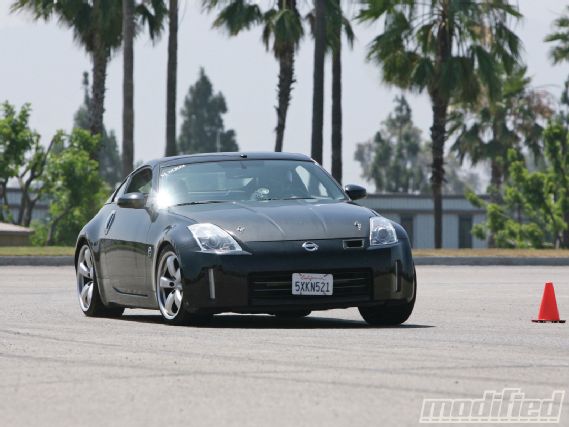 | Tires Explained - Tired 101 - Tech
| Tires Explained - Tired 101 - Tech
One of the biggest ways to improve your car’s cornering power both on and off the track is choosing the right tire for your application. As we’ve all experienced firsthand, the more traction or grip a tire produces, the faster your car will be able to go around corners. It’s also well understood that every tire has a finite amount of traction it can provide before it starts to slip, which is the part where you end up in the ditch and have to dig out your AAA card. But what exactly leads to that moment when traction turns into slip (experienced as understeer or oversteer) and you find yourself scrambling to stay on the road? There are many factors that determine a tire’s grip level — starting with how soft and sticky the compound is — but other design elements like carcass construction, sidewall stiffness, tread block design and tire pressure and temperature also play key roles. When you start to look at all the elements and moving parts in a tire, suddenly what seem like simple rubber donuts become incredibly complex and highly sophisticated pieces of rolling engineering.
That’s where we come in to break it down for you in laymen’s terms. Hopefully, after reading this article you’ll be better informed as to what type of tire suits your driving needs the best. But before we dissect tire anatomy, we want to remind you that there’s no perfect tire out there. Every tire gives up performance in one category to be better in another; that’s why there are so many different types of tires on the market.
Tread Blocks
These large blocks of rubber are the contact point between the road and the tire. The larger the tread block, the better the traction is; however, large tread blocks tend to produce more road noise than smaller ones, but because of their large contact area, they’re stiffer and less prone to vibration and chunking under aggressive driving conditions. Medium- to small-sized tread blocks are commonly found on all-season and wet-performance-oriented tires, whereas summer-only tires usually rely on heavy use of large stiff tread blocks for their superior dry-handling characteristics.
Every tire gives up performance in one category to be better in another; that’s why there are so many different types of tires on the market.
Sipes
These are slits in the tread blocks that aid traction in wet and snowy weather conditions. They are most common on winter tires, but many all-season tires incorporate them as well. Sipes provide an increase in biting edges when they expand and open up on contact, helping evacuate slush, snow or water from the tread, thereby increasing available grip. Sipes compromise handling performance, though, since they can make a tire feel squirmy and vague in warm, dry conditions. That’s why you won’t find them on any UHP summer or track-oriented tires.
Grooves
Much like sipes, grooves help improve traction in wet weather. They are the main channels in a tire that help evacuate water quickly and effectively, reducing the chances of hydroplanning. The deeper and more numerous the grooves are, the greater wet performance you can expect out of a tire.
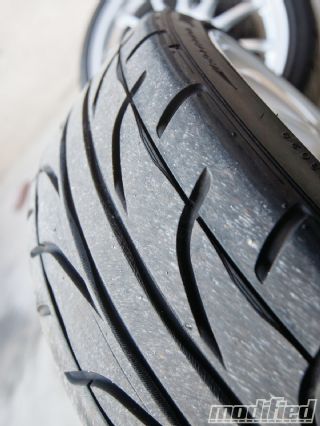 |
Most ultra-high-performance tires have very few grooves and large tread blocks to maximize grip at the expense of wet-weather performance.
|
Most ultra-high-performance tires have very few grooves and large tread blocks to maximize grip at the expense of wet-weather performance.
Radial Plies & Steel Belts
The internal structure of a tire consists of radial plies and steel belts. The interwoven construction of these two materials is what gives tires their strength, stiffness and durability. When a tire is put under load, the radial plies and steel belts are what resist these forces and help the tire maintain its shape and remain in consistent contact with the road.
Another benefit of these elements is that tires run cooler and are less susceptible to punctures and blowouts. The only real drawback is weight. The more material used usually helps aid tire stability and stiffness but adds weight to the tire, which in turn adds unsprung mass to the car.
Sidewall
Sidewall construction is important to performance because a stiffer sidewall will provide more control, faster turn-in response and a more responsive feel over the road. This highly responsive feel is ideal for enthusiasts, but can be a bit nerve-racking for newbs and grandmas since stiff sidewalls tend to be unforgiving and snappy in nature. Sidewall stiffness also plays an important role in ride quality. Obviously, the softer the sidewall, the more comfortable a tire will feel (and vice versa).
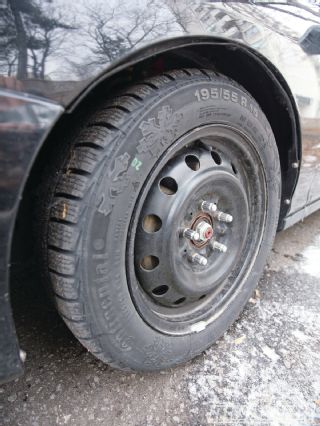 |
Tread sipes, such as the ones commonly found on winter tires, effectively improve traction in wet and snowy weather conditions.
|
Tread sipes, such as the ones commonly found on winter tires, effectively improve traction in wet and snowy weather conditions.
The same goes for sidewall height. A low-profile tire will be less forgiving to bumps and holes in the road versus a taller one, but a tall sidewall is prone to more roll and is therefore going to reduce turn-in response and steering feel.
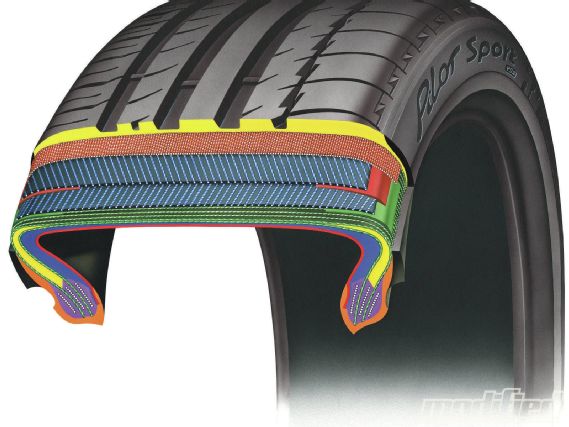 | Tires Explained - Tired 101 - Tech
| Tires Explained - Tired 101 - Tech
Treadwear
This is the rating that manufacturers provide for how long a tire should last. Using Uniform Tire Quality Grade standards (UTQG), a number is provided on the sidewall to indicate treadwear. The problem is that every tire manufacturer sets its own treadwear rating, meaning a 300 treadwear on one tire can still have a longer lifespan than a 300 treadwear rating listed on a different tire.
Despite this discrepancy, treadwear rating is a good overall indicator of the type of performance you can expect out of a tire. Based on our findings, 100 UTQG and below usually means the tire is meant for track duty, and even though it can be driven on the street, the rate at which it wears will be very high. A 100–200 UTQG rating will still provide ample grip with an acceptable wear life on the street and 200–350 UTQG tires are longer lasting, but give up some dry grip as a result. This is amplified even more with 350+ UTQG tires, which can provide exceptionally long tread life, but it’s at the expense of dry traction. In our experience, any tire rated over 350 UTQG will overheat quickly and lose grip when pushed beyond its design limits during aggressive driving on a track.
Speed Ratings
Speed ratings let you know what the safe and sustained maximum speed a tire can travel at. These U.S. government ratings are a good indicator of the kind of performance you can expect out of a tire. P-rated tires won’t have the grip or stability of H-rated tires, so if all-out performance is your goal, then aim for the highest speed-rated tire you can afford. Remember, though, a V-rated tire on a Honda Civic doesn’t mean it will be able to reach that speed, nor should you attempt to.
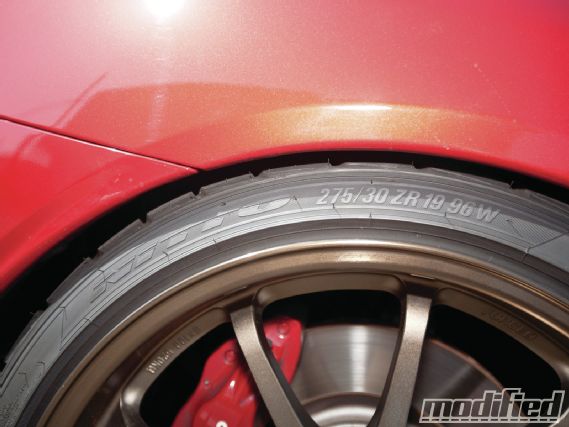 |
A lot of information is placed on the sidewall of a tire, including sizing — the first number stands for tire width, the second for sidewall height, the Z refers to the speed rating, the R stands for radial and the third for tire diameter (all measured in inches). The 96 in this case stands for the load index and the W is the speed rating. Note that the Z in front of the R is an older speed-rating placement that’s still used on this particular tire.
|
A lot of information is placed on the sidewall of a tire, including sizing — the first number stands for tire width, the second for sidewall height, the Z refers to the speed rating, the R stands for radial and the third for tire diameter (all measured in inches). The 96 in this case stands for the load index and the W is the speed rating. Note that the Z in front of the R is an older speed-rating placement that’s still used on this particular tire.
L75 mph120 km/h M81 mph130 km/h N87 mph140 km/h P93 mph150 km/h Q99 mph160 km/h R106 mph170 km/h S112 mph180 km/h T118 mph190 km/h U124 mph200 km/h H130 mph210 km/h V149 mph240 km/h Z149+ mph240+ km/h W168 mph270 km/h Y186 mph299 km/h (Y)186+ mph299+ km/h
All-season vs. UHP Summer vs. R-compound vs. Slicks
Common sense states that you shouldn’t drive a summer tire through the winter months, just like you really shouldn’t use an all-season tire at the track. That being said, the new generation of UHP all-season tires is very capable and has remarkable performance in dry conditions, even around a racetrack. We still recommend getting a proper UHP summer tire for track use, though, because less performance-oriented tires tend to overheat, scallop and chunk quickly under the harsh conditions found at a racetrack, not to mention provide less consistent grip.
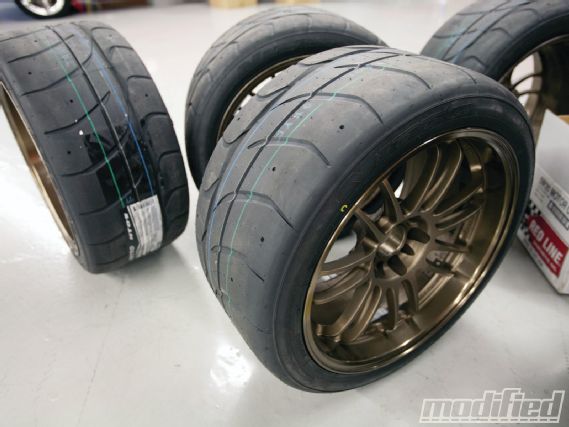 |
DOT R-compound tires have very shallow and strategically placed grooves that make them legal for street use, but don’t sacrifice much grip. They are purpose-built to provide ample grip for most street-legal cars taken to the track.
|
DOT R-compound tires have very shallow and strategically placed grooves that make them legal for street use, but don’t sacrifice much grip. They are purpose-built to provide ample grip for most street-legal cars taken to the track.
Depending on how soft the compound is, you can expect about one season’s worth of track use out of a set of R-comps.
Once you’ve become comfortable driving on a UHP summer tire at the track, we recommend stepping up to a DOT R-compound tire that provides uncompromised grip at the expense of streetability. Although these tires are still considered street legal since they’re DOT-approved, most R-compound tires will wear extremely quickly during normal road use, not to mention their wet performance is far from optimal. But put them on a racetrack, and they provide tremendous grip and consistency since the tread compound is designed to work best at the higher temperatures generated during track use. Depending on how soft the compound is, you can expect about one season’s worth of track use out of a set of R-comps (though this also depends on how many events you attend and how aggressively you use/abuse them).
Racing slicks are the crème de la crème when it comes to outright grip and on-track performance. They’re not street legal and rarely have any grooves (thus the term “slicks”). Their soft compounds provide maximum dry grip for a relatively short period of time. That’s why you see pro race teams going through a set of tires in a single session or two. Most weekend warriors don’t have the budget to run slicks, but we recommend trying them out if you ever have the chance because the grip level is just mind-blowing. (though the extra grip can be wasted on a car or driver that’s not able to fully utilize it).
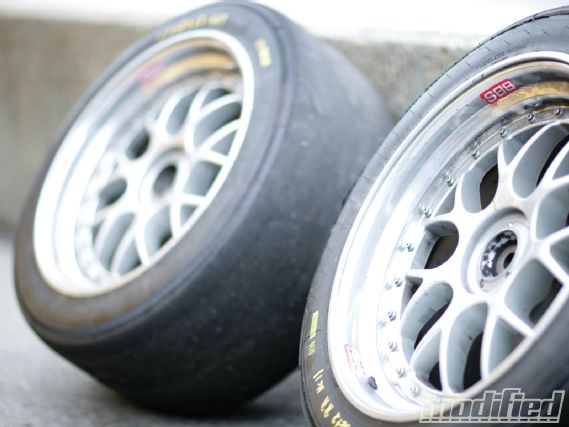 |
Racing slicks are no-compromise, purpose-built, performance tires for the racetrack. They’re designed to provide the maximum amount of grip possible in a relatively short amount of time.
|
Racing slicks are no-compromise, purpose-built, performance tires for the racetrack. They’re designed to provide the maximum amount of grip possible in a relatively short amount of time.
Armed with this information, you should be able to make an educated decision as to what tire suits your needs the best. After that, there’s another world of education that you’ll want to learn to effectively dial in your tire at the track. Look for a future article on tire pressure and temperatures and how they can help improve your laps times.
